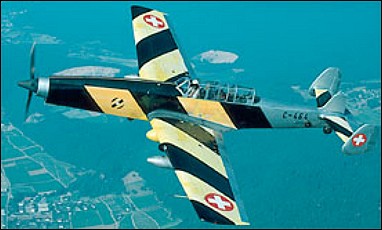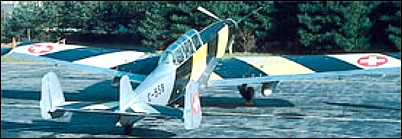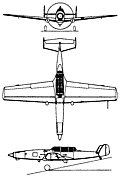 |
Federal Aircraft Factory C-3605 Schlepp1968 |  |
| TARGET-TUG | Virtual Aircraft Museum / Switzerland / Federal Aircraft Factory |
 |
Development of the Farner-Werke C-3605 two-seat target-tug can be traced back to the Fabrique Federate C-3602, two prototypes of which were built in 1939-40 for long-range reconnaissance and ground-attack. Following flight tests, modifications were made and an initial batch entered production as the C-3603. Ten were built, and after service evaluation a further 142 followed, serving with the Swiss air force between 1942 and 1952 in the combat role. Two others, designated C-3603-1 TR, were produced for training and parachute tests. In 1945 a C-3603-1 was converted for target-towing; after considerable flight testing a successful installation was evolved and fitted to 20 other aircraft within a year. Further improvements followed, and in 1946 Farner-Werke at Grenchen converted a C-3603-1 into a more advanced target-tug. A long tube was fitted from the rear cockpit to eject the target sleeve above the taiiplane and between the twin fins, with a cable-cutting device available to the pilot. Twenty C-3603s were converted to this standard. Development of the basic airframe had meanwhile continued with the C-3604 a version using the 933kW Saurer YS-2 engine in place of the 746kW Hispano-Suiza used in earlier models. A prototype and 12 production C-3604s were built, the type entering service in 1947-48. Spares produced for the C-3603 and not used enabled a further six C-3603-1 s to be assembled in 1948. During the early 1950s a requirement for an aircraft to tow illuminated targets at night was met with the conversion of a C-3603-1, and this machine remained in service until replaced by the C-3605 in 1972. Further conversions of 40 C-3603-1 s to target-tugs began in 1953, while another aircraft was fitted beneath one wing with a winch built by ML Aviation in the UK for high-speed towing, and a ballast tank beneath the other wing. In the same year, 20 more C-3603-1s were converted by the military at Dubendorf for catastrophe relief using underwing supply containers. The ultimate development of the C-3603 airframe came when the His-pano-Suiza engines of the 40 C-3603-1 conversions began to wear out. Various types of foreign aircraft were considered as replacements but all were rejected for various reasons and a proposal to re-engine the C-3603-1 with a Lycoming T53-L-7 turboprop was accepted. A prototype was converted and flown on 19 August 1968; it was handed over to the Swiss air force in December 1968 for acceptance trials, which proved satisfactory and, with a few modifications, a series of 23 aircraft was re-engined and given the new designation C-3605. A third, central, fin was added and the lower weight of the turboprop necessitated a major 1.82m increase in the length of the nose. The first C-3605s entered service in 1971 and the last was delivered in January 1973.
|  COMPANY PROFILE | |||||||||||||||||||||||||||||||||||||||||||||||||||||||||||||
 |

|


